From the World Meteorological Organization's (WMO) International Cloud Atlas, the official worldwide standard for clouds, the following are definitions of the ten basic cloud types, divided by their height:
विश्व मौसम विज्ञान संगठन (WMO) के अंतर्राष्ट्रीय क्लाउड एटलस, जो बादलों के लिए आधिकारिक विश्वव्यापी मानक है, से दस बुनियादी बादल प्रकारों की परिभाषाएं, उनकी ऊंचाई के आधार पर विभाजित की गई हैं:
High-Level Clouds उच्च स्तरीय बादल
Cirrus (Ci), cirrocumulus (Cc), and cirrostratus (Cs) are high level clouds. They are typically thin and white in appearance, but can appear in a magnificent array of colors when the sun is low on the horizon.
सिरस (Ci), सिरोक्यूम्यलस (Cc), और सिरोस्ट्रेटस (Cs) उच्च स्तर के बादल हैं। वे आम तौर पर पतले और सफ़ेद दिखते हैं, लेकिन जब सूरज क्षितिज पर होता है तो वे कई रंगों में दिखाई दे सकते हैं।
Cirrus (Ci)
Detached clouds in the form of white, delicate filaments, mostly in patches or narrow bands. They may have a fibrous (hair-like) and/or silky sheen appearance.
Cirrus clouds are always composed of ice crystals, and their transparent character depends upon the degree of separation of the crystals. As a rule, when these clouds cross the sun's disk, they hardly diminish its brightness. When they are exceptionally thick, they may veil its light and obscure its contour.
Before sunrise and after sunset, cirrus are often colored bright yellow or red. These clouds are lit up long before other clouds and fade out much later; some time after sunset they become gray.
At all hours of the day, cirrus near the horizon are often of a yellowish color. This is due to the distance the light travels through the atmosphere at a low angle.
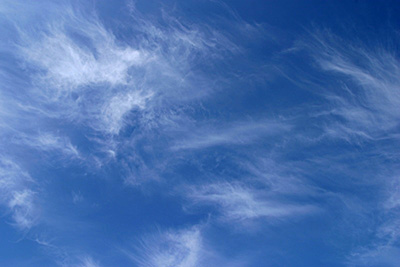
सिरस (Ci)
सफेद, नाजुक तंतुओं के रूप में अलग-अलग बादल, ज़्यादातर पैच या संकीर्ण बैंड में। वे रेशेदार (बालों की तरह) और/या रेशमी चमक वाले दिख सकते हैं।
सिरस बादल हमेशा बर्फ के क्रिस्टल से बने होते हैं, और उनका पारदर्शी चरित्र क्रिस्टल के अलग होने की डिग्री पर निर्भर करता है। एक नियम के रूप में, जब ये बादल सूर्य की डिस्क को पार करते हैं, तो वे शायद ही इसकी चमक को कम करते हैं। जब वे असाधारण रूप से घने होते हैं, तो वे इसके प्रकाश को ढक सकते हैं और इसके समोच्च को अस्पष्ट कर सकते हैं।
सूर्योदय से पहले और सूर्यास्त के बाद, सिरस अक्सर चमकीले पीले या लाल रंग के होते हैं। ये बादल अन्य बादलों से बहुत पहले चमकते हैं और बहुत बाद में फीके पड़ जाते हैं; सूर्यास्त के कुछ समय बाद वे भूरे हो जाते हैं।
दिन के सभी घंटों में, क्षितिज के पास सिरस अक्सर पीले रंग के होते हैं। ऐसा इसलिए होता है क्योंकि प्रकाश कम कोण पर वायुमंडल से होकर गुजरता है।
Cirrocumulus (Cc)
Thin and white, these clouds look like a patchy sheet or layer arranged somewhat-regularly into grains or ripples without shading. Most of these elements have an apparent width of less than one degree (approximately width of the little finger held at arm's length).
Predominantly made of ice crystals, cirrocumulus often form in connection with cirrus or cirrostratus or from a degraded state of these cloud types and are short-lived.
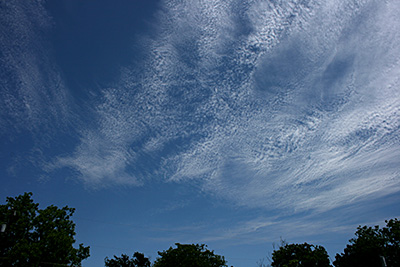
सिरोक्यूम्यलस (Cc)
पतले और सफ़ेद, ये बादल एक पैची शीट या परत की तरह दिखते हैं जो बिना किसी छायांकन के कुछ हद तक नियमित रूप से दानों या लहरों में व्यवस्थित होते हैं। इनमें से ज़्यादातर तत्वों की स्पष्ट चौड़ाई एक डिग्री से भी कम होती है (लगभग हाथ की लंबाई पर रखी गई छोटी उंगली की चौड़ाई)।
मुख्य रूप से बर्फ के क्रिस्टल से बने, सिरोक्यूम्यलस अक्सर सिरस या सिरोस्ट्रेटस के संबंध में या इन बादल प्रकारों की खराब अवस्था से बनते हैं और अल्पकालिक होते हैं।
Cirrostratus (Cs)
Transparent, whitish veil-like clouds with a fibrous (hair-like) or smooth appearance. A sheet of cirrostratus is very extensive and can cover the whole sky.
During the day, when the sun is sufficiently high above the horizon, the sheet is never thick enough to prevent shadows of objects on the ground.
A veil of cirrostratus may have a similar appearance to a milky veil of fog (or thin stratus), but is distinguished by a halo phenomena nearly always produced around the Sun or Moon shining through a layer of cirrostratus.
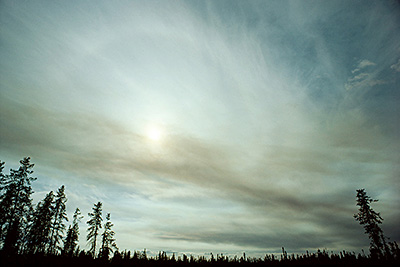
सिरोस्ट्रेटस (Cs)
पारदर्शी, सफ़ेद रंग के घूंघट जैसे बादल जो रेशेदार (बालों जैसे) या चिकने दिखाई देते हैं। सिरोस्ट्रेटस की एक चादर बहुत विस्तृत होती है और पूरे आकाश को ढक सकती है। दिन के समय, जब सूर्य क्षितिज से काफी ऊपर होता है, तो चादर कभी भी इतनी मोटी नहीं होती कि ज़मीन पर मौजूद वस्तुओं की छाया को रोक सके। सिरोस्ट्रेटस का एक पर्दा कोहरे के दूधिया परदे (या पतले स्ट्रेटस) जैसा दिखाई दे सकता है, लेकिन यह एक प्रभामंडल घटना से अलग होता है जो लगभग हमेशा सूर्य या चंद्रमा के चारों ओर सिरोस्ट्रेटस की एक परत के माध्यम से चमकता है।
Mid-Level Clouds
Altocumulus (Ac), altostratus (As), and nimbostratus (Ns) are mid-level clouds composed primarily of water droplets. However, they can be composed of ice crystals when temperatures are low enough.
In Latin, alto means 'high' yet altostratus and altocumulus clouds are classified as mid-level clouds. 'Alto' is used to distinguish these "higher-level" clouds from their low-level liquid-based counterpart clouds, stratus and cumulus.
मध्य-स्तर के बादल
अल्टोक्यूमुलस (एसी), अल्टोस्ट्रेटस (एएस), और निंबोस्ट्रेटस (एनएस) मध्य-स्तर के बादल हैं जो मुख्य रूप से पानी की बूंदों से बने होते हैं। हालाँकि, जब तापमान काफी कम होता है तो वे बर्फ के क्रिस्टल से बने हो सकते हैं।
लैटिन में, अल्टो का अर्थ है 'उच्च' फिर भी अल्टोस्ट्रेटस और अल्टोक्यूमुलस बादलों को मध्य-स्तर के बादलों के रूप में वर्गीकृत किया जाता है। 'ऑल्टो' का उपयोग इन "उच्च-स्तर" बादलों को उनके निम्न-स्तर के तरल-आधारित समकक्ष बादलों, स्ट्रेटस और क्यूम्यलस से अलग करने के लिए किया जाता है।
Altocumulus (Ac)
White and/or gray patchy, sheet, or layered clouds generally composed of laminae (plates), rounded masses, or rolls. They may be partly fibrous or diffuse and may or may not be merged.
Most of these regularly arranged small elements have an apparent width of one to five degrees (larger than the little finger and smaller than three fingers held at arm's length).
When the edge or a thin semitransparent patch of altocumulus passes in front of the sun or moon, a corona appears. This colored ring has red on the outside and blue inside and occurs within a few degrees of the sun or moon.
The most common mid-level cloud, multiple layers of altocumulus often appear at different levels at the same time. Many times, altocumulus will appear with other cloud types.
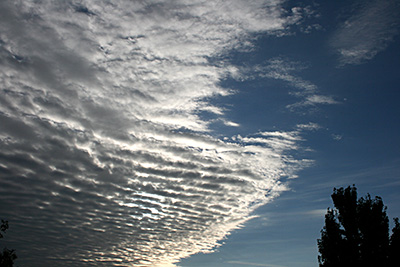
आल्टोक्यूम्यलस (एसी)
सफ़ेद और/या ग्रे पैची, शीट या परतदार बादल जो आम तौर पर लैमिना (प्लेट), गोल द्रव्यमान या रोल से बने होते हैं। वे आंशिक रूप से रेशेदार या फैले हुए हो सकते हैं और विलय हो भी सकते हैं और नहीं भी।
इन नियमित रूप से व्यवस्थित छोटे तत्वों में से अधिकांश की स्पष्ट चौड़ाई एक से पांच डिग्री (छोटी उंगली से बड़ी और हाथ की लंबाई पर रखी गई तीन उंगलियों से छोटी) होती है।
जब आल्टोक्यूम्यलस का किनारा या पतला अर्धपारदर्शी पैच सूर्य या चंद्रमा के सामने से गुजरता है, तो एक कोरोना दिखाई देता है। इस रंगीन वलय का बाहरी भाग लाल और अंदर नीला होता है और यह सूर्य या चंद्रमा से कुछ डिग्री की दूरी पर होता है।
सबसे आम मध्य-स्तरीय बादल, आल्टोक्यूम्यलस की कई परतें अक्सर एक ही समय में अलग-अलग स्तरों पर दिखाई देती हैं। कई बार, आल्टोक्यूम्यलस अन्य प्रकार के बादलों के साथ दिखाई देगा।
Altostratus (As)
Gray or bluish cloud sheets or layers of striated or fibrous clouds that totally or partially cover the sky. They are thin enough to regularly reveal the sun as if seen through ground glass.
Altostratus clouds do not produce a halo phenomenon nor are the shadows of objects on the ground visible.
Sometimes virga (streaks of rain) is seen hanging from altostratus and at times may even reach the ground, causing very light precipitation.
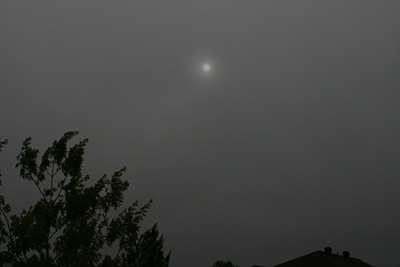
आल्टोस्ट्रेटस (एएस)
धूसर या नीले रंग के बादल या धारीदार या रेशेदार बादलों की परतें जो आकाश को पूरी तरह या आंशिक रूप से ढक लेती हैं। वे इतने पतले होते हैं कि नियमित रूप से सूर्य को ऐसे दिखाते हैं जैसे कि ग्राउंड ग्लास के माध्यम से देखा गया हो।
आल्टोस्ट्रेटस बादल प्रभामंडल जैसी घटना उत्पन्न नहीं करते हैं और न ही ज़मीन पर मौजूद वस्तुओं की छाया दिखाई देती है।
कभी-कभी विरगा (बारिश की धारियाँ) आल्टोस्ट्रेटस से लटकती हुई दिखाई देती हैं और कभी-कभी ज़मीन तक भी पहुँच सकती हैं, जिससे बहुत हल्की वर्षा होती है।
Nimbostratus (Ns)
Resulting from thickening altostratus, this is a dark gray cloud layer diffused by falling rain or snow. It is thick enough throughout to blot out the sun. Low, ragged clouds frequently occur beneath this cloud and sometimes merge with its base.
The cloud base lowers as precipitation continues. Because of the lowering base, it is often erroneously called a low-level cloud. Both altostratus and nimbostratus can extend into the high level of clouds.
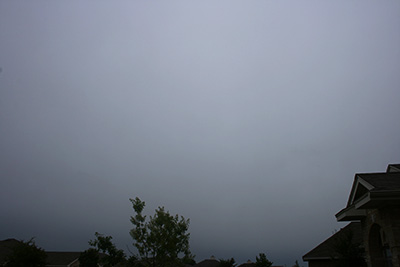
निंबोस्ट्रेटस (एनएस)
अल्टोस्ट्रेटस के मोटे होने से उत्पन्न, यह एक गहरे भूरे रंग की बादल परत है जो बारिश या बर्फ गिरने से फैलती है। यह पूरी तरह से इतना मोटा होता है कि सूरज को ढक लेता है। इस बादल के नीचे अक्सर कम, उबड़-खाबड़ बादल होते हैं और कभी-कभी इसके आधार के साथ विलीन हो जाते हैं।
वर्षा जारी रहने पर बादल का आधार कम होता जाता है। आधार के कम होने के कारण, इसे अक्सर ग़लती से निम्न-स्तरीय बादल कहा जाता है। अल्टोस्ट्रेटस और निंबोस्ट्रेटस दोनों ही बादलों के उच्च स्तर तक फैल सकते हैं।
Low-Level Clouds
Cumulus (Cu), stratocumulus (Sc), stratus (St), and cumulonimbus (Cb) are low clouds composed of water droplets. Cumulonimbus, with its strong vertical updraft, extends well into the high level of clouds.
निम्न-स्तर के बादल
क्यूम्यलस (Cu), स्ट्रेटोक्यूम्यलस (Sc), स्ट्रेटस (St), और क्यूम्यलोनिम्बस (Cb) पानी की बूंदों से बने निम्न बादल हैं। क्यूम्यलोनिम्बस, अपने मजबूत ऊर्ध्वाधर अपड्राफ्ट के साथ, बादलों के उच्च स्तर तक अच्छी तरह से फैला हुआ है।
Cumulus (Cu)
Detached, generally dense clouds and with sharp outlines that develop vertically in the form of rising mounds, domes, or towers with bulging upper parts often resembling a cauliflower.
The sunlit parts of these clouds are mostly brilliant white while their bases are relatively dark and horizontal.
Over land, cumulus develops on days of clear skies due diurnal convection. It appears in the morning, grows, and then more or less dissolves again toward evening.
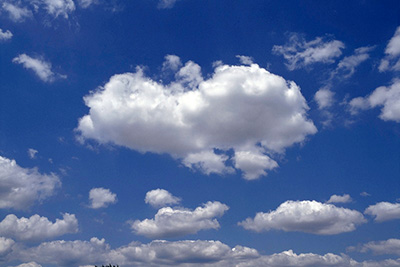
क्यूम्यलस (Cu)
अलग-अलग, आम तौर पर घने बादल और तीखे रूपरेखा वाले जो ऊपर की ओर बढ़ते हुए टीलों, गुंबदों या टावरों के रूप में विकसित होते हैं, जिनके ऊपरी हिस्से अक्सर फूलगोभी जैसे दिखते हैं।
इन बादलों के सूर्यप्रकाशित हिस्से ज़्यादातर चमकीले सफ़ेद होते हैं जबकि उनके आधार अपेक्षाकृत गहरे और क्षैतिज होते हैं।
ज़मीन पर, क्यूम्यलस दिन के संवहन के कारण साफ़ आसमान वाले दिनों में विकसित होता है। यह सुबह दिखाई देता है, बढ़ता है, और फिर शाम को कमोबेश फिर से घुल जाता है।
Cumulonimbus (Cb)
The thunderstorm cloud, this is a heavy and dense cloud in the form of a mountain or huge tower. The upper portion is usually smoothed, fibrous, or striated and nearly always flattened in the shape of an anvil or vast plume.
Under the base of this cloud, which is often very dark, there are commonly low ragged clouds that may or may not merge with the base. They produce precipitation, which sometimes is in the form of virga.
Cumulonimbus clouds also produce hail and tornadoes.
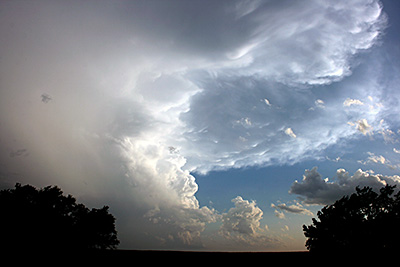
क्यूम्यलोनिम्बस (सीबी)
तूफ़ानी बादल, यह पहाड़ या विशाल मीनार के आकार का एक भारी और घना बादल है। ऊपरी भाग आमतौर पर चिकना, रेशेदार या धारीदार होता है और लगभग हमेशा निहाई या विशाल पंख के आकार में चपटा होता है।
इस बादल के आधार के नीचे, जो अक्सर बहुत अंधेरा होता है, आमतौर पर कम उबड़-खाबड़ बादल होते हैं जो आधार के साथ विलीन हो सकते हैं या नहीं भी हो सकते हैं। वे वर्षा उत्पन्न करते हैं, जो कभी-कभी विरगा के रूप में होती है।
क्यूम्यलोनिम्बस बादल ओले और बवंडर भी उत्पन्न करते हैं।
Stratocumulus (Sc)
Gray or whitish patchy, sheet, or layered clouds that almost always have dark tessellations (honeycomb appearance), rounded masses, or rolls. Except for virga, they are non-fibrous and may or may not be merged.
They also have regularly arranged small elements with an apparent width of more than five degrees (three fingers at arm's length).
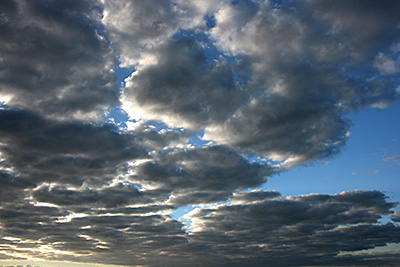
स्ट्रेटोक्यूमुलस (एससी)
ग्रे या सफ़ेद धब्बेदार, चादर या परतदार बादल जिनमें लगभग हमेशा गहरे रंग के टेसेलेशन (मधुमक्खी के छत्ते जैसी आकृति), गोल द्रव्यमान या रोल होते हैं। विरगा को छोड़कर, वे गैर-रेशेदार होते हैं और विलय हो भी सकते हैं और नहीं भी।
उनके पास नियमित रूप से व्यवस्थित छोटे तत्व भी होते हैं जिनकी स्पष्ट चौड़ाई पाँच डिग्री (हाथ की लंबाई पर तीन अंगुल) से अधिक होती है।
Stratus (St)
A generally gray cloud layer with a uniform base which may, if thick enough, produce drizzle, ice prisms, or snow grains. When the sun is visible through this cloud, its outline is clearly discernible.
Often, when a layer of stratus breaks up and dissipates, blue sky is seen.
Sometimes appearing as ragged sheets, stratus clouds do not produce a halo phenomenon except, occasionally, at very low temperatures.
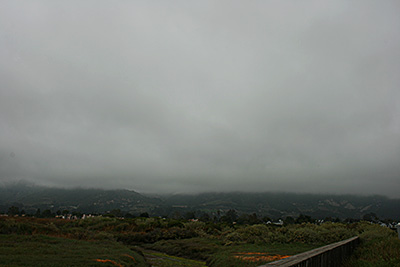
स्ट्रेटस (सेंट)
एक समान आधार वाली सामान्यतः धूसर बादल परत जो यदि पर्याप्त मोटी हो तो बूंदाबांदी, बर्फ के प्रिज्म या बर्फ के कण उत्पन्न कर सकती है। जब सूर्य इस बादल के माध्यम से दिखाई देता है, तो इसकी रूपरेखा स्पष्ट रूप से दिखाई देती है।
अक्सर, जब स्ट्रेटस की एक परत टूट जाती है और फैल जाती है, तो नीला आकाश दिखाई देता है।
कभी-कभी उबड़-खाबड़ चादरों के रूप में दिखाई देने वाले स्ट्रेटस बादल कभी-कभी बहुत कम तापमान को छोड़कर, प्रभामंडल घटना उत्पन्न नहीं करते हैं।
If sunlight is white, why is the sky blue?
The color of the sky is a result of light bouncing off gasses in the atmosphere in what is called Rayleigh scattering, named after physicist Lord Rayleigh.
The atoms and molecules comprising the atmospheric gasses are much smaller than the wavelengths of light emitted by the sun. As a result, collisions cause the relatively larger wavelengths to scatter unequally, with shorter wavelengths scattering more than longer ones.
As sunlight enters the atmosphere, much of the short violet light waves scatter first, but very high in the atmosphere and therefore not readily seen. Indigo light waves scatter next and can be seen from high altitudes such as from jet airplanes flying at normal cruising altitudes.
Blue light waves scatter next, at a rate about four times stronger than red light waves. The volume of scattering by the shorter blue light waves, along with additional scattering by violet and indigo, dominate scattering by the remaining color wavelengths. Therefore, we primarily perceive the blue light as the color of the sky.
यदि सूर्य का प्रकाश सफेद है, तो आकाश नीला क्यों है?
आकाश का रंग वायुमंडल में गैसों से टकराने वाले प्रकाश का परिणाम है, जिसे रेले स्कैटरिंग कहा जाता है, जिसका नाम भौतिक विज्ञानी लॉर्ड रेले के नाम पर रखा गया है।
वायुमंडलीय गैसों में शामिल परमाणु और अणु सूर्य द्वारा उत्सर्जित प्रकाश की तरंगदैर्घ्य से बहुत छोटे होते हैं। परिणामस्वरूप, टकराव के कारण अपेक्षाकृत बड़ी तरंगदैर्घ्य असमान रूप से बिखर जाती हैं, जिसमें छोटी तरंगदैर्घ्य लंबी तरंगों की तुलना में अधिक बिखरती हैं।
जैसे ही सूर्य का प्रकाश वायुमंडल में प्रवेश करता है, छोटी बैंगनी प्रकाश तरंगें सबसे पहले बिखरती हैं, लेकिन वायुमंडल में बहुत ऊपर होती हैं और इसलिए आसानी से दिखाई नहीं देती हैं। इंडिगो प्रकाश तरंगें इसके बाद बिखरती हैं और इन्हें सामान्य क्रूज़िंग ऊंचाई पर उड़ने वाले जेट हवाई जहाजों जैसे उच्च ऊंचाई से देखा जा सकता है।
नीली प्रकाश तरंगें इसके बाद बिखरती हैं, जो लाल प्रकाश तरंगों की तुलना में लगभग चार गुना अधिक दर से बिखरती हैं। छोटी नीली प्रकाश तरंगों द्वारा बिखरने की मात्रा, बैंगनी और इंडिगो द्वारा अतिरिक्त बिखराव के साथ, शेष रंग तरंगदैर्घ्य द्वारा बिखराव पर हावी होती है। इसलिए, हम मुख्य रूप से नीले प्रकाश को आकाश के रंग के रूप में देखते हैं।
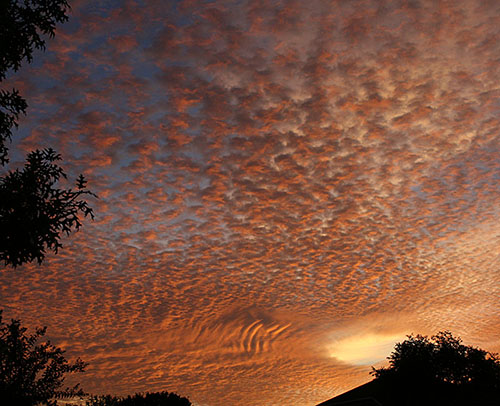
If the sky is blue, why are clouds white?
Unlike Rayleigh scattering, where the light waves are larger than the gas molecules in the atmosphere, the individual water droplets that make up a cloud are of similar size to the wavelength of sunlight. When the droplets and light waves are of similar size, a different type of scattering, called Mie scattering, occurs.
Mie scattering does not differentiate individual wavelength colors and, therefore, scatters all wavelengths of color the same. We perceive this equally-scattered light as white.
However, clouds do not always appear white. Haze and dust in the atmosphere can cause them to appear yellow, orange, or red. As clouds thicken, sunlight passing through them will diminish or be blocked, giving the cloud a gray color. If there is no direct sunlight striking the cloud, it may even reflect the color of the sky and appear bluish.
अगर आसमान नीला है, तो बादल सफ़ेद क्यों होते हैं?
रेले स्कैटरिंग के विपरीत, जहाँ प्रकाश तरंगें वायुमंडल में गैस के अणुओं से बड़ी होती हैं, बादल बनाने वाली अलग-अलग पानी की बूँदें सूर्य के प्रकाश की तरंगदैर्घ्य के समान आकार की होती हैं। जब बूँदें और प्रकाश तरंगें समान आकार की होती हैं, तो एक अलग तरह का स्कैटरिंग होता है, जिसे माई स्कैटरिंग कहा जाता है।
मी स्कैटरिंग अलग-अलग तरंगदैर्घ्य वाले रंगों में अंतर नहीं करता है और इसलिए, सभी रंगों की तरंगदैर्घ्य को समान रूप से स्कैटर करता है। हम इस समान रूप से बिखरे हुए प्रकाश को सफ़ेद के रूप में देखते हैं।
हालाँकि, बादल हमेशा सफ़ेद नहीं दिखते। वायुमंडल में धुंध और धूल के कारण वे पीले, नारंगी या लाल दिखाई दे सकते हैं। जैसे-जैसे बादल घने होते हैं, उनसे होकर गुजरने वाली सूर्य की रोशनी कम हो जाती है या अवरुद्ध हो जाती है, जिससे बादल का रंग ग्रे हो जाता है। अगर बादल पर सीधी धूप नहीं पड़ रही है, तो यह आसमान के रंग को भी प्रतिबिंबित कर सकता है और नीला दिखाई दे सकता है।
Rayleigh and Mie
Some of the most picturesque clouds occur close to sunrise and sunset, when they appear in brilliant yellows, oranges, and reds. The colors result from a combination of Rayleigh and Mie scattering.
At sunrise and sunset, the Sun is low in the sky, and its light passes close to the Earth’s surface where the atmosphere is most dense. As light enters the atmosphere at this angle, it refracts with the greatest bend due to this higher density, causing the light's path to lengthen, further allowing for more Rayleigh scattering.
Most of the shorter blue wavelengths are scattered on this longer path, leaving the majority of longer waves to continue. As light continues to move through the atmosphere, yellow wavelengths are scattered leaving orange wavelengths. Further scattering of orange wavelengths leaves red as the predominant color of sunlight.
Therefore, near sunrise and sunset, a cloud's color will be whatever sunlight color it receives after Rayleigh scattering. Mei scattering scatters all remaining wavelength colors equally within the cloud.
रेले और मी
कुछ सबसे खूबसूरत बादल सूर्योदय और सूर्यास्त के करीब होते हैं, जब वे चमकीले पीले, नारंगी और लाल रंग में दिखाई देते हैं। ये रंग रेले और मी बिखराव के संयोजन से बनते हैं।
सूर्योदय और सूर्यास्त के समय, सूर्य आकाश में कम होता है, और इसका प्रकाश पृथ्वी की सतह के करीब से गुजरता है जहाँ वायुमंडल सबसे घना होता है। जैसे ही प्रकाश इस कोण पर वायुमंडल में प्रवेश करता है, यह इस उच्च घनत्व के कारण सबसे बड़े मोड़ के साथ अपवर्तित होता है, जिससे प्रकाश का मार्ग लंबा हो जाता है, जिससे और अधिक रेले बिखराव होता है।
अधिकांश छोटी नीली तरंगदैर्ध्य इस लंबे पथ पर बिखर जाती हैं, जिससे अधिकांश लंबी तरंगें जारी रहती हैं। जैसे-जैसे प्रकाश वायुमंडल से आगे बढ़ता है, नारंगी तरंगदैर्ध्य को छोड़कर पीली तरंगदैर्ध्य बिखर जाती है। नारंगी तरंगदैर्ध्य के आगे बिखराव से लाल रंग सूर्य के प्रकाश का प्रमुख रंग बन जाता है।
इसलिए, सूर्योदय और सूर्यास्त के समय, बादल का रंग रेले बिखराव के बाद प्राप्त होने वाले सूर्य के प्रकाश के रंग के समान होगा। मी बिखराव बादल के भीतर सभी शेष तरंगदैर्ध्य रंगों को समान रूप से बिखेरता है।
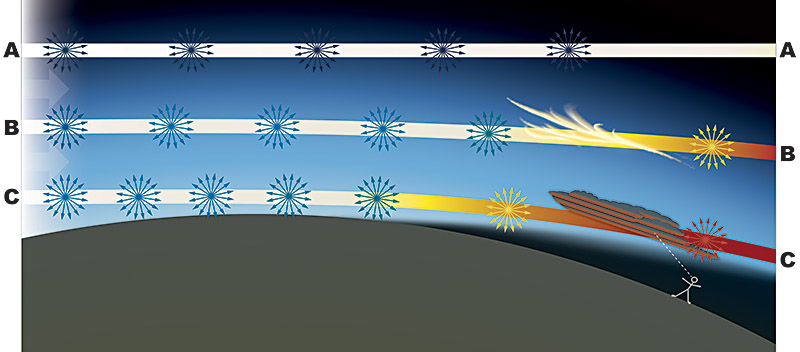
The Color of Perception
Sometimes, under direct sunlight, clouds will appear gray or dark gray against a blue sky or larger backdrop of white clouds. There are usually two reasons for this effect.
- The clouds may be semi-transparent which allows the background blue sky to be seen through the cloud, thereby giving it a darker appearance.
- More commonly, the contrast between the background (blue sky or additional clouds) and the foreground cloud overwhelms our vision. In essence, the overwhelming brightness of the background tricks our eyes into perceiving the relatively darker foreground clouds as gray.